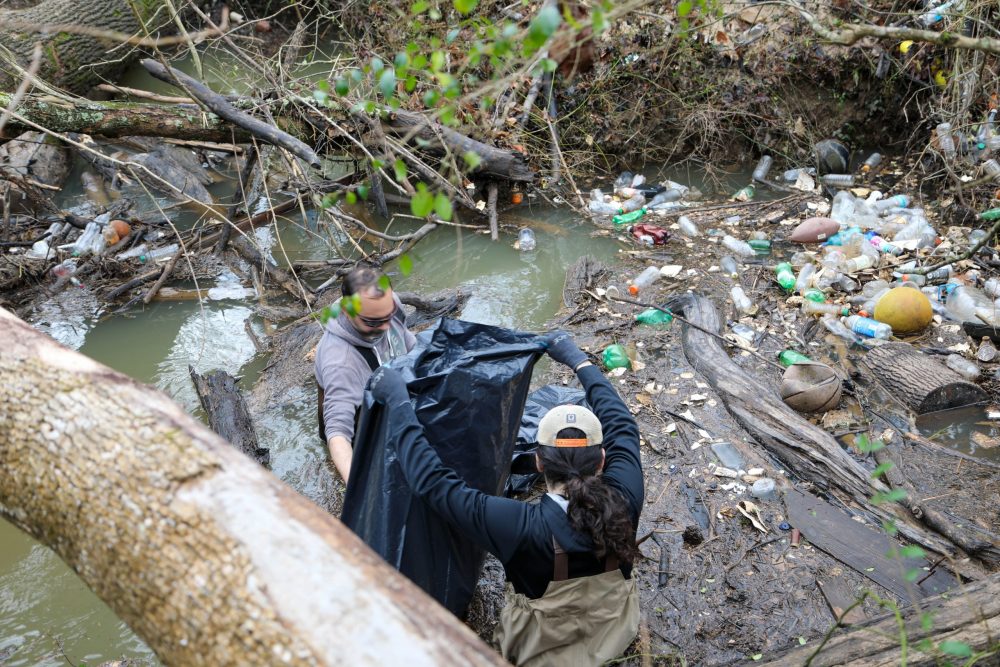On a recent Saturday morning, a tarp on the boardwalk by Durham’s Third Fork Creek in Southwest Durham revealed trash of all kinds — energy drink bottles, sports balls, old milk cartons, even half of a disco ball. People in gloves hunched over the tarp, sorting and counting every piece of garbage bigger than a quarter.
“Who needs a job?” asked Halle Amick, one of Haw River Assembly’s newly appointed volunteer team leaders, chest-deep into the creek.
All around her, Durhamites wearing waders sunk deeper into the water, on the hunt for more garbage to fish out. Some scrambled up a tree trunk laid across the creek, holding their arms out for balance while trekking to the other side. A father wore his baby son in a carrier while retrieving litter on the surrounding shore — the mother was in the water.
On the last Saturday of every month, volunteers join the Haw River Assembly in cleaning out trash traps placed throughout the watershed. Given the recent rain, the trap bears more trash than usual — around 75% of manmade litter in waters and streams like the Haw is carried there from roads by stormwater runoff. Eventually, if unremoved, this trash will continue flowing downstream until reaching the ocean.
Recently, Durham officials have struggled to pass regulations aimed at reducing plastic pollution. In September, the North Carolina General Assembly passed a law prohibiting local municipalities from banning or regulating single-use plastic bags. The law passed just two days before a 10 cent bag fee was set to come to a vote in Durham — part of a larger proposal spearheaded by Don’t Waste Durham and the Duke Environmental Law and Policy Clinic. The legislature’s ruling also blocked Asheville from passing a plastic bag ban.
“That’s just fundamentally unfair, to require somebody to manage this waste, but deny them the tools that they find necessary in that management process,” said Michelle Nowlin, co-director of the Duke Environmental Law and Policy Clinic.
The Haw River starts in Forsyth County, stretching around 110 miles and eventually emptying into the Cape Fear River, among dozens of other tributaries. The Haw flows into Jordan Lake, which supplies drinking water to nearly 700,000 people in the Triangle, according to the North Carolina Collaboratory at the University of Chapel Hill.
“It is our right to have clean, fishable, swimmable water. So I swim, I paddle, I play…,” said Emily Sutton, Haw Riverkeeper. “That’s our right.”
The Haw River Assembly was founded in 1982 to protect and restore the Haw River and Jordan Lake. As of this past November, they’ve installed five trash traps throughout the watershed, including in Chapel Hill’s Bolin Creek and Durham’s Third Fork Creek.
The three-sided trash traps employ a simple mechanism to capture litter. As trash flows downstream, it gets directed into a steel cable cage. A floating chain link fence acts as a gate to prevent trash from continuing its path downstream. The traps are held in place by ground anchors at four points along the shoreline. Fish and other wildlife can swim underneath the traps, protecting them from harm.
It’s hard to walk by Third Fork Creek and avoid the giant floating trap in the water — and this is on purpose.
“Why is this here? What is the problem? What is in our water? How does it get there?” are all questions Haw River Assembly plastics program assistant Madison Haley hopes passersby reflect on when strolling by the creek.
The traps capture the trash and allow for removal before plastics deteriorate into microplastics. Microplastics have been detected in all kinds of marine and land organisms. While the human health impacts of microplastics are still being studied, the United Nations Development Programme links compounds from plastics to health issues like endocrine disruption, weight gain, insulin resistance, decreased reproductive health and cancer.

Amick first started her own litter pickup routine during the pandemic, after noticing increased pollution from takeout containers and other trash. Eventually, she became a loyal monthly Haw River Assembly trash trap cleaner until she landed herself the role of volunteer team leader.
“There aren’t a lot of volunteer opportunities where you can spend two hours and go from a mountain of trash to a pristine stream. That’s the most rewarding thing,” Amick said.
Amick fell in love with the trash traps for their simplicity and ease at which they capture and collect litter.
“Hopefully, downstream — literally and figuratively — this will turn into solutions, like keeping these plastic bottles and styrofoam pieces and sports balls out of the water stream in the first place.”
Above (from top): Team leader Halle Amick helps volunteers corral plastic debris and other litter clogging Third Fork Creek. Photos by Abigail Bromberger — The 9th Street Journal











